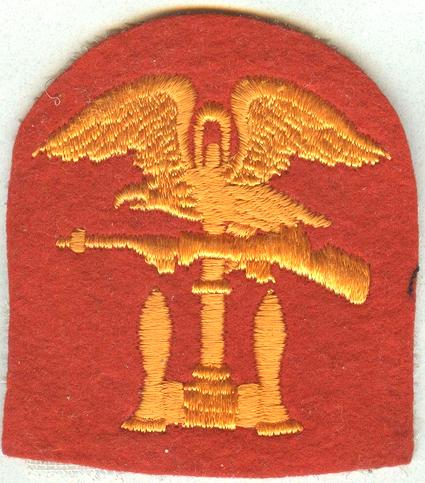Grandy Ferrell Scarber
Born 28
April 1926 in Post
Oak, Jack County, Texas
Died 08 January 2015 in Bowie, Montague County, Texas
Military Assignments from 27 April 1944 to 21 May 1946
National
Museum of the Pacific War
Fredericksburg, Texas
Memorial location Bush Gallery Wall, Row 5, Section near side entrance
Unveiled 19 September 2015
The direct link to Ferrell Scarber's Memorial Plague is here,
just in case the website's search engine is still broken.
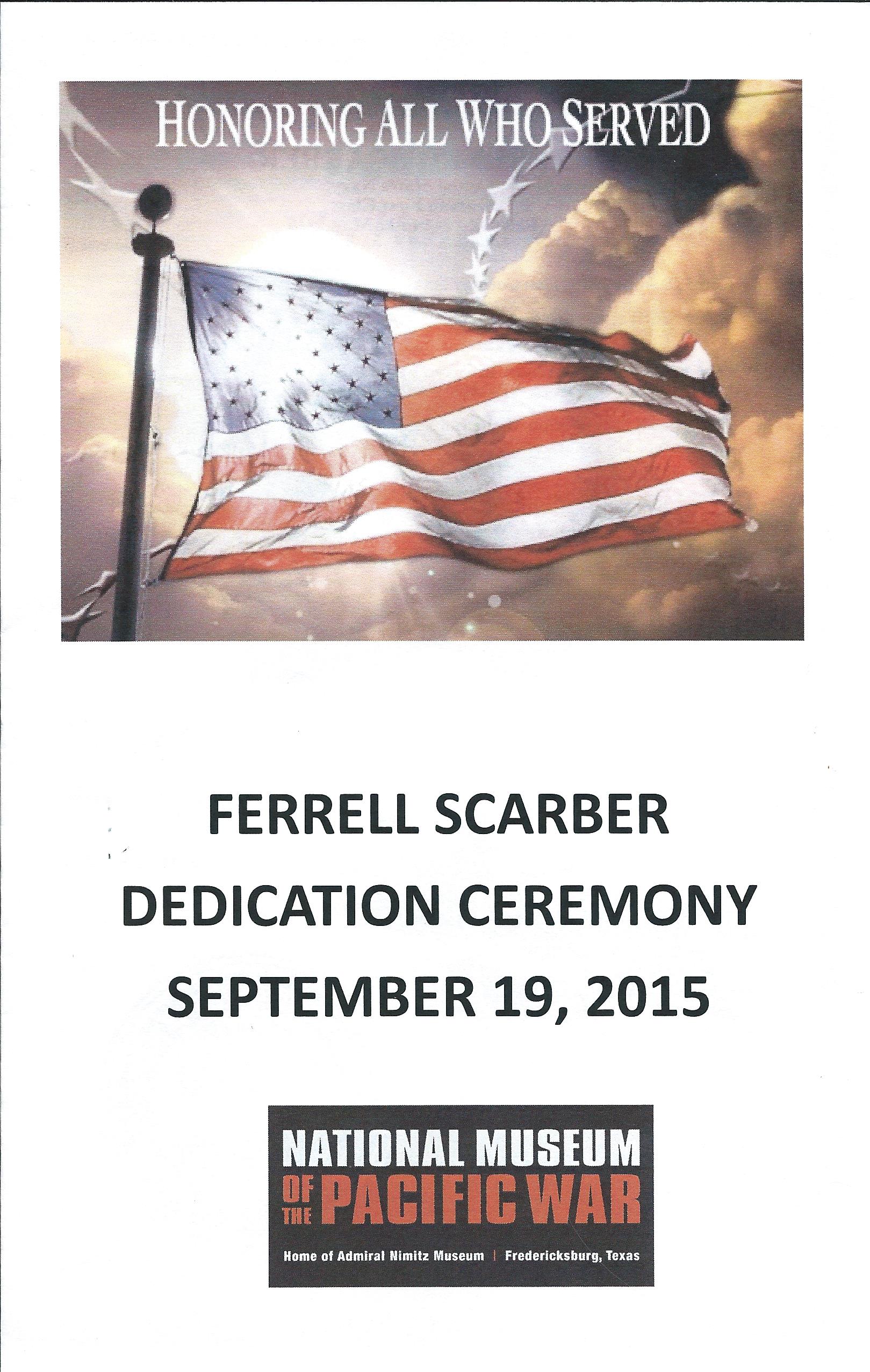
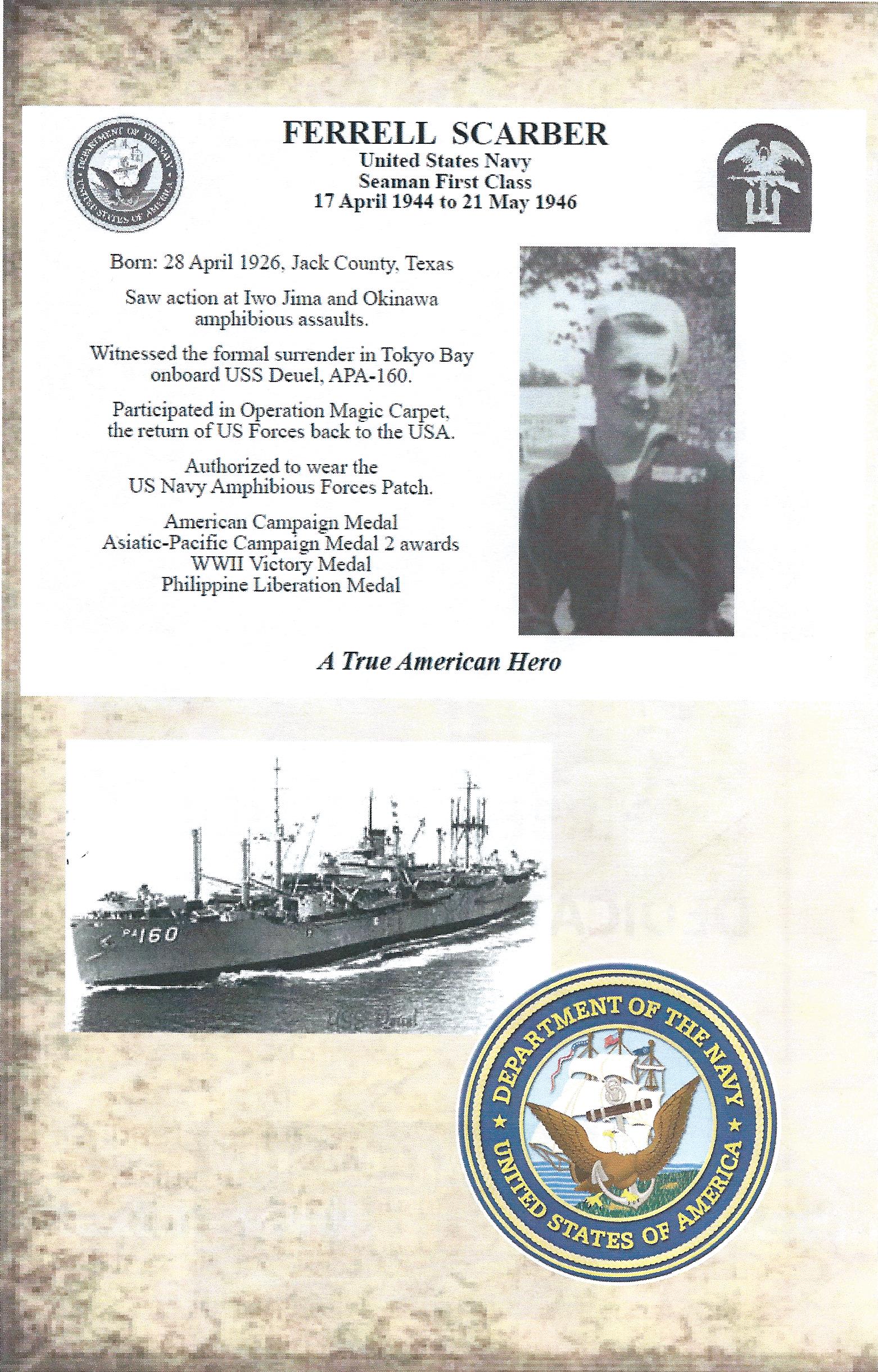
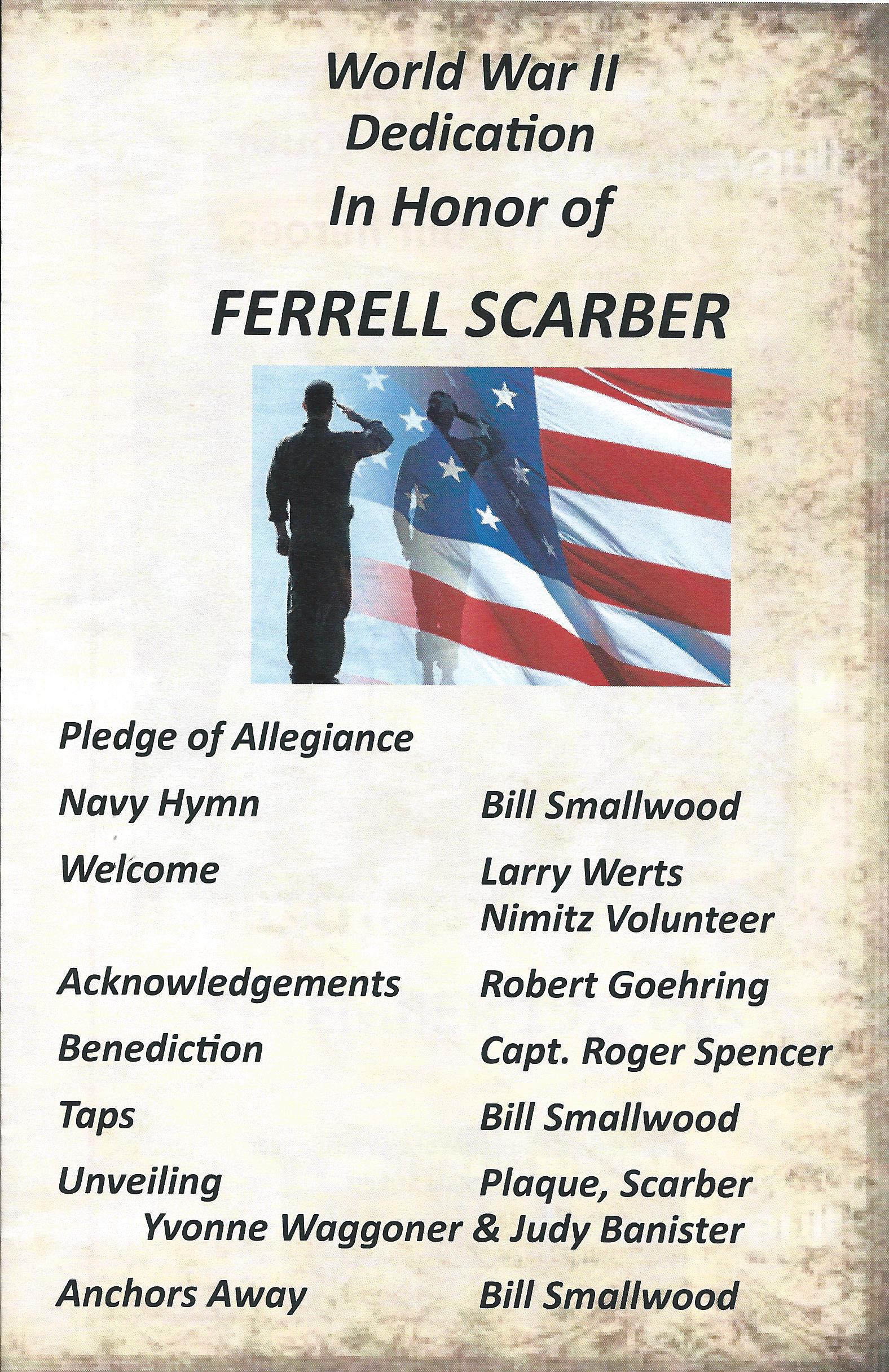
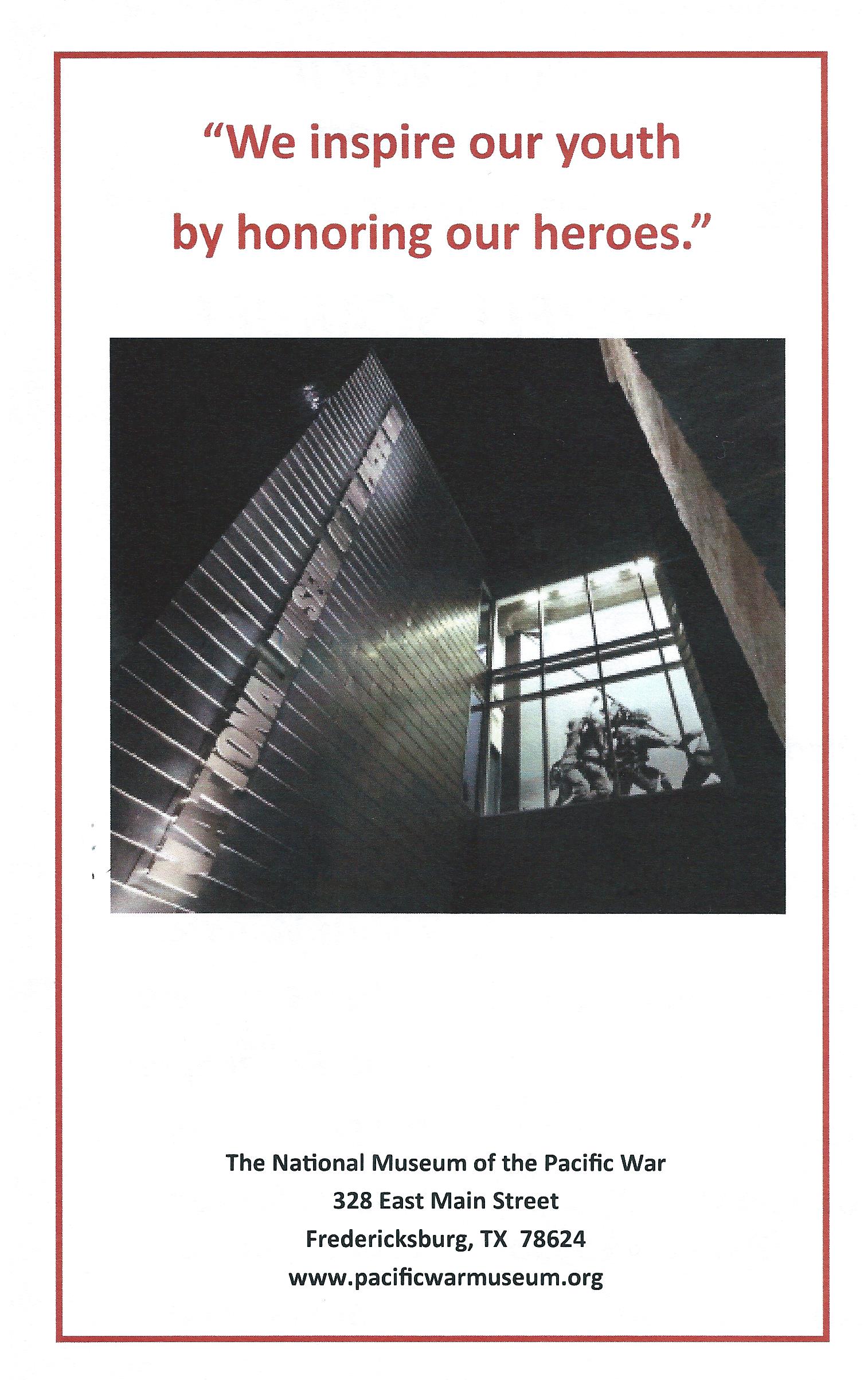
|
Arrived |
Unit
/ Organization |
Location |
|
27
Apr 44 |
Enlisted
at Naval Recruiting Station as A.S. (Apprentice Seaman),
USNR, V-6. Listed at 5 foot 8 inches, 123 pounds, age 17
years 11 months. |
Dallas,
Texas |
|
|
On
inactive service. |
|
|
8
May 44 |
Recalled
to active duty. Pay for A.S. - $50.00 per month. |
Dallas,
Texas |
|
12
May – 7 Jul 44 |
Reported
to US Naval Training Command, Farragut, Idaho, for Recruit
Training. Qualified as marksman on indoor and outdoor range,
qualified swimmer, night lookout trainer, gas mask gas
chamber instructions. Advanced to S2c (Seaman Second Class).
Pay for S2c - $54.00 per month. |
Farragut,
Idaho |
|
8
Jul – 26 Jul 44 |
On
leave and travel to next command. |
|
|
27
Jul 44 |
Reported
aboard APA RecBks, Naval Station Seattle, Washington. |
Seattle,
Washington |
|
28
Jul – 26 Sep 44 |
Attended
USS Deuel Detail
and APA Pre-commissioning School. |
Seattle,
Washington |
|
26
Sep 44 |
Authorized
to wear AMPHIFOR insignia IAW BuPers C.L. #173-44. |
Seattle,
Washington |
|
6
Oct 44 |
Reported
aboard Naval Air Station, Astoria, Oregon for duty CFO USS Deuel APA-160. |
Astoria,
Oregon |
|
13
Oct 44 |
USS
Deuel
APA-160. Started serving outside the continental limits of
the U.S. |
At
Sea |
|
11
Jan 45 |
Advanced
to S1c (Seaman First Class). Pay for S1c - $66.00 per month. |
At
Sea |
|
28
May to 29 Aug 45 |
Served
continuously in the Philippine Area. Entitled to wear the
American Theatre and Asiatic-Pacific Area ribbons. Auth:
AlNav 104-44. |
At
Sea - Philippines |
|
2
Feb 45 |
Crossed
180th Meridian onboard USS
Deuel APA-160. |
At
Sea |
|
19
– 27 Feb 45 |
Participated
in Iwo Jima operations onboard USS
Deuel APA-160. |
At
Sea – Iwo Jima |
|
8
Mar 45 |
Crossed
the Equator bound southward from a secret port to an unknown
port aboard USS Deuel
APA-160. |
At
Sea |
|
9
– 14 Apr 45 |
Participated
in Okinawa operation aboard USS
Deuel APA-160. |
At
Sea – Okinawa |
|
2
Sep 45 |
With
the US Navy in Tokyo Bay aboard USS
Deuel APA-160 to witness the Formal Surrender of the
Empire of Japan to Allied Forces. |
Tokyo
Bay, Japan |
|
Oct
45 – Jan 46 |
Participated
in Operation Magic Carpet. |
At
Sea |
|
Jan
46 – Apr 46 |
USS
Deuel APA-160 transferred from the Pacific Fleet to the
Atlantic Fleet control. Changed homeport location from
Washington to Norfolk, Virginia. Scheduled for
decommissioning. |
At
Sea |
|
15
May 46 |
Detached
from USS Deuel
APA-160 for transfer to PSC, Norman, Oklahoma and discharge. |
Norfolk,
Virginia |
|
18
May 46 |
Reported
aboard PSC (Personnel Separation Center), Norman, Oklahoma |
Norman,
Oklahoma |
|
21
May 46 |
Honorable
Discharge from US Navy. Served 2 years 25 days. |
Norman,
Oklahoma |
Decorations and Awards:
US Navy Amphibious Forces Patch
|
Authorized
for US Navy personnel assigned to Amphibious Forces. Unusual
in that Navy uniforms usually did not have patches. This
patch was authorized in 1944 but was discontinued in 1947. |
Seaman First Class Cuff Stripes
|
Seaman
uniforms only had rank insignia on the cuffs of their dress
uniforms. While in working uniform, the non-rated seaman had
no indication of pay grade. |
American Campaign Medal
Row 1, Ribbon 1
|
The
requirements for the American Campaign Medal were: a service
member was required to either perform one year of duty
(cumulative) within the continental borders of the United
States, or perform 30 days consecutive or 60 non-consecutive
days of duty outside the borders of the United States but
within the American Theater of Operations. The eligibility
dates of the American Campaign Medal were from December 7,
1941 to March 2, 1946. |
Asiatic-Pacific Campaign Medal
Row 1, Ribbon 2
|
Awarded
this medal with two campaign stars (Iwo Jima operation
between 15 Feb – 16 Mar 1945 and Okinawa Gunto operation 17
Mar – 30 Jun 1945). The Asiatic-Pacific Campaign Medal was
awarded to any member of the United States Military who
served in the Pacific Theater from 1941 to 1945.
There were 48 Navy official campaigns of the
Pacific Theater, denoted on the service ribbon by campaign
stars. |
WWII Victory Medal
Row 2, Ribbon 1
|
Established
by Congress on 09 Jul 1945, and awarded to members of the US
Armed Forces for service between 07 Dec 1941 and 31 Dec 1946 |
Navy Occupation Service Ribbon
Row 2, Ribbon 2
|
Established
by Navy Department General Order No. 10 of 28 January 1948.
Awarded to Naval Service Personnel who participated in the
occupation of the territories of the enemies of the United
States during World War I1 and subsequent to the surrender
of these enemies. Occupation duty in the Asiatic-Pacific
area may be credited to organizations for duty performed
between 2 September 1945 and 27 April 1952. |
Row 2, Ribbon 3
|
Incorrect
image for this ribbon. |
Philippine Liberation Medal
Row 3, Ribbon 1
|
The
Philippine Liberation Medal is a military award of the
Republic of the Philippines which was created by an order of
Commonwealth Army of the Philippines Headquarters on
December 20, 1944. The award was presented to any service
member, of both Philippine Commonwealth and allied
militaries, who participated in the liberation of the
Philippine Islands between the dates of October 17, 1944 and
September 2, 1945. |
Navy Rifle Marksman
Row 3, Ribbon 2
|
The
U.S. Navy has issued the Navy Rifle Marksmanship Ribbon
since 1920. To earn this award, the Sailor must score a
minimum level using the current service wide rifle. In 1944,
the M1 Garand semi-automatic .30 Caliber Carbine was the
standard qualification weapon. |
Navy Pistol Marksman
Row 3, Ribbon 3
|
The
U.S. Navy has issued the Navy Pistol Marksmanship Ribbon
since 1920. To earn this award, the Sailor must score a
minimum level using the current service wide pistol. In
1944, the weapon was the Colt M1911 semi-automatic .45 ACP
(Automatic Colt Pistol). |
Miscellaneous
information about different elements of
his career.
Amphibious
Forces
Patch
.
Farragut
Naval
Training Station, Idaho
Eleanor Roosevelt allegedly noticed Lake Pend Oreille on a flight to
Seattle. Knowing that President Roosevelt was seeking a location
for a secure
inland naval training center, she mentioned it to him and he made
a secret tour
of the area. Ground was broken in March 1942, and by September the
base had a
population of 55,000, making it the largest city in Idaho. Liberty
trains to
Spokane ran three times daily. At the time Farragut was the
second-largest
training center in the world (behind Naval Station Great Lakes).
Over 293,000 sailors received
basic
training at Farragut during its 30 months of existence. The last
recruit
graduated in March 1945 and the facility was decommissioned in
June 1946. It
was also used as a prisoner of war camp; nearly 900 Germans worked
as gardeners
and maintenance men.
U.S.S. Deuel,
APA-160
USS Deuel (APA-160) was a Haskell-class attack transport built and used by the US Navy in World War II. She was a Victory ship design, VC2-S-AP5. She was named after Deuel County, Nebraska and Deuel County, South Dakota, USA.
Deuel was launched 9 September 1944 by Oregon Shipbuilding Corp., Portland, Oregon, under a Maritime Commission contract; sponsored by Mrs. J. Himmelright transferred to the Navy 13 October 1944; and commissioned the same day, Captain D. G. McMillan in command.
Deuel sailed from San Diego 25 November 1944, and after training at Pearl Harbor staged at Saipan for the invasion of Iwo Jima. On 19 February 1945 she helped land the 5th Marines in the initial assault. She stood off the island for 6 days, embarking casualties for transportation to hospitals at Guam. After replacing her boats at Florida Island, and training at Espiritu Santo, she sailed from Ulithi 4 April to transport support troops to Okinawa where she embarked casualties for transfer to Saipan.
From 28 May to 27 August 1945 Deuel operated in the Philippines on transport and training duty. She carried Army troops to Japan for occupation duty in September, then returned to San Pedro Bay, Leyte to embark more troops and a civil administration party which she landed at Kure between 5 and 11 October. Assigned to "Magic Carpet" duty, she carried servicemen from the Pacific home to the west coast until January 1946, then sailed for the east coast where she was placed out of commission 17 May 1946, berthed at Norfolk.
Operation Magic Carpet was the post-World War II effort by the War Shipping Administration to repatriate over eight million American military personnel from the European, Pacific, and Asian theaters. Hundreds of Liberty ships, Victory ships, and troop transports began repatriating soldiers from Europe in June 1945. Beginning in October 1945, over 370 navy ships were used for repatriation duties in the Pacific. Warships, such as aircraft carriers, battleships, hospital ships, and large numbers of assault transports were used. The European phase of Operation Magic Carpet concluded in February 1946 while the Pacific phase continued until September 1946.
Battle
of
Iwo Jima
Iwo Jima, which means Sulfur Island, was strategically important as an air base for fighter escorts supporting long-range bombing missions against mainland Japan. Because of the distance between mainland Japan and U.S. bases in the Mariana Islands, the capture of Iwo Jima would provide an emergency landing strip for crippled B-29s returning from bombing runs. The seizure of Iwo would allow for sea and air blockades, the ability to conduct intensive air bombardment and to destroy the enemy's air and naval capabilities.
The seizure of Iwo Jima was deemed necessary, but the prize would not come easy. The fighting that took place during the 36-day assault would be immortalized in the words of Commander, Pacific Fleet/Commander in Chief, Pacific Ocean Areas Admiral Chester W. Nimitz, who said, "Among the Americans who served on Iwo Island, uncommon valor was a common virtue."
To the Japanese leadership, the capture of Iwo Jima meant the battle for Okinawa, and the invasion of Japan itself, was not far off.
On D-day, 19 February 1945, more than 450 ships massed off Iwo as the H-hour bombardment pounded the island. Shortly after 9 a.m., Marines of the 4th and 5th divisions hit beaches Green, Red, Yellow and Blue abreast, initially finding little enemy resistance. Coarse volcanic sand hampered the movement of men and machines as they struggled to move up the beach. As the protective naval gunfire subsided to allow for the Marine advance, the Japanese emerged from their fortified underground positions to begin a heavy barrage of fire against the invading force.
The 4th Marine Division pushed forward against heavy opposition to take the Quarry, a Japanese strong point. The 5th Marine Division's 28th Marines had the mission of isolating Mount Suribachi. Both tasks were accomplished that day.
The 36-day assault resulted in more than 26,000 American casualties, including 6,800 dead. Of the 20,000 Japanese defenders, only 1,083 survived. The Marines' efforts, however, provided a vital link in the U.S. chain of bomber bases. By war's end, 2,400 B-29 bombers carrying 27,000 crewmen made unscheduled landings on the island.
Historians described U.S. forces' attack against the Japanese defense as "throwing human flesh against reinforced concrete." In the end, Iwo Jima was won not only by the fighting spirit of the Marines, but by the meticulous planning and support provided by the Navy and Army through supply efforts, medical care, and air and naval gunfire.
Twenty-seven Medals of Honor were awarded to Marines and sailors, many posthumously, more than were awarded for any other single operation during the war.
Eighteen U.S. Navy ships were sunk or badly damaged by enemy action with a loss of approximately 337 Sailors killed and 493 wounded.
Any
errors
on this page were transcription errors made while reading the copied
official record of Grandy Ferrell Scarber.
